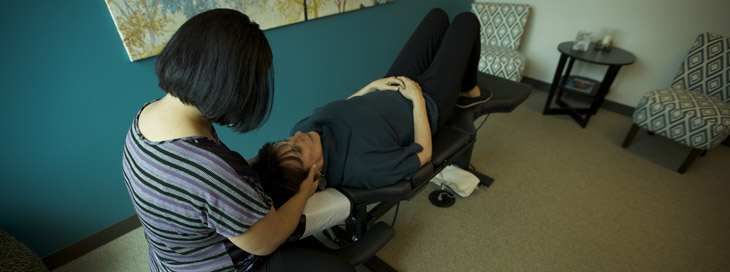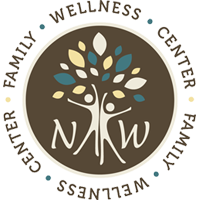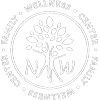
Chiropractors emphasize the conservative management of the neuromusculoskeletal system without the use of medicines or surgery, with special emphasis on the spine. Back and neck pain are the specialties of chiropractic but many chiropractors treat ailments other than musculoskeletal issues.
Chiropractic medicine is more than just spinal manipulations. Chiropractors use a variety of treatment modalities to help the body to heal itself and return the patient to a pain-free and healthy life. Chiropractic Manipulative Therapy in our office includes the following techniques: High Velocity/Low Amplitude (HVLA) Spinal Adjusting, Extremity Adjusting, Diversified Technique, Activator Method, Gonstead Technique and Thompson Technique utilizing drop table methods and sacral blocking.
The Kinesio Taping® Method is a definitive rehabilitative taping technique that is designed to facilitate the body’s natural healing process while providing support and stability to muscles and joints without restricting the range of motion to the area the tape covers. Kinesio® Tex Tape provides extended soft tissue manipulation and prolongs the benefits of manual therapy administered within the clinical setting. It is equivalent to having your practitioner’s hands support you for 5 days while you are outside of the clinic.
Latex-free and wearable for days at a time despite vigorous sweat inducing activity, Kinesio® Tex Tape is safe for populations ranging from pediatric to geriatric, and successfully treats a variety of orthopaedic, neuromuscular, neurological and other medical conditions. Kinesio® Tex Tape can be applied in hundreds of ways and has the ability to re-educate the neuromuscular system, reduce pain and inflammation, enhance performance, prevent injury and promote good circulation and healing, and assist in returning the body to homeostasis.
Results from studies have also shown that Kinesio® Taping is also beneficial in the following areas. It improves lymphatic drainage, minimizing swelling and bruising. It also improves blood flow to the soft tissue it covers, as well as has a numbing effect. This effect happens as the tape lifts the skin, thus decreasing pressure on the pain receptors. This tape also increases awareness of body proprioception, thus allowing an individual to understand their sense of position and physical space within their surroundings.
Often, we will prescribe specific strengthening exercises for patients with back, neck, and extremity problems. These exercises can decrease pain, prevent muscle deterioration, promote joint health, increase strength, stability and range of motion, and protect against new or recurring injuries.
We will show you how to do the exercises and supervise you until you are comfortable doing them on your own. It’s important to keep up with your exercises as prescribed (similarly to drug prescriptions). Studies show that individuals who follow their exercise instructions heal faster than those who do not.
Following an injury, therapeutic stretching is an important way to prevent scar tissue from forming. Even after the injury has healed, maintaining a regular stretching program helps keep tissues flexible, increases mobility, and protects you from new injuries. As with exercise, we will instruct you on proper stretching techniques and will supervise you until you are comfortable enough to do them on your own.
We utilize a variety of hands-on soft tissue therapies to improve the function of the soft tissues (muscles, ligaments, tendons, and joint capsules).
In an active release treatment, our providers use their hands to evaluate the texture, tightness and mobility of the soft tissue. Using hand pressure, the practitioner works to remove or break up the fibrous adhesions, with stretching motions generally in the direction of venous and lymphatic flow, although the opposite direction may occasionally be used. Active release is used to treat conditions related to adhesions or scar tissue in muscles. As adhesions build up, muscles become shorter and weaker, the motion of muscles and joints are altered, and nerves can be compressed. As a result, tissues suffer from decreased blood supply, pain, and poor mobility. This technique has been commonly referred to as pin and stretch as our practitioners take a muscle from a shortened position to a lengthened position while “pinning” the muscle down with their hands during this motion. Treatment times are usually short but highly effective should be limited to every other day at a maximum.
MRT is considered to be an ultimate mind/body therapy that is safe, gentle and consistently effective in producing results in reducing pain, headaches, fibromyalgia symptoms, and increases range of motion and function. Trauma, inflammatory responses, and/or surgical procedures create myofascial restrictions that can produce tensile pressures of approximately 2,000 pounds per square inch on pain sensitive structures that do not show up in many of the standard tests (x-rays, myelograms, CAT scans, electromyography, etc.)
The medical approach is to drug patients so they temporarily are free from pain, but does nothing about the “straight-jacket” of pressure that is causing the pain. Traditional therapy methods treat the symptoms caused by the pressure of the “straightjacket” but do nothing about the “straightjacket” itself which causes and perpetuates the symptoms. This is why so many patients only have temporary results never seeming to get better with traditional therapy. Myofascial Release treats the entire myofascial complex eliminating the pressure of the restricted myofascial system (the straightjacket) that causes the symptoms. Myofascial Release is a safe and very effective hands-on technique that involves applying gentle sustained pressure into the myofascial connective tissue restrictions to eliminate pain and restore motion. This essential “time element” has to do with the viscous flow and the piezoelectric phenomenon: a low load (gentle pressure) applied slowly will allow a viscoelastic medium (fascia) to elongate.
The use of Myofascial Release allows us to look at each patient as a unique individual. Our one-on-one therapy sessions are hands-on treatments during which our therapists use a multitude of Myofascial Release techniques and movement therapy. We promote independence through education in proper body mechanics and movement, self-treatment instruction, enhancement of strength, improved flexibility, and postural and movement awareness.
Each Myofascial Release Treatment session is performed directly on skin without oils, creams or machinery. This enables the therapist to accurately detect fascial restrictions and apply the appropriate amount of sustained pressure to facilitate release of the fascia.
A trigger point is a tight area within muscle tissue that causes pain in other parts of the body. A trigger point in the back, for example, may reduce referral pain in the neck. The neck, now acting as a satellite trigger point, may then cause pain in the head. The pain may be sharp and intense or a dull ache.
Trigger point therapy is specifically designed to alleviate the source of the pain through cycles of isolated pressure and release. During trigger point therapy, the recipient actively participates through deep breathing as well as identifying the exact location and intensity of the discomfort.
The results and benefits of trigger point are releasing constricted areas in the muscles thus alleviating pain. You can experience a significant decrease in pain after just one treatment. Receiving massage with trigger point therapy on a regular basis can help naturally manage pain and stress from chronic injuries.
This type of therapy uses light electrical pulses that are transmitted to specific areas of the body through electrodes placed on the skin. There are many different types of electrical stimulation. Some are more beneficial for pain relief or to reduce inflammation, some best treat muscle spasm, and some actually cause muscles to contract in order to reduce muscle atrophy.
A TENS (transcutaneous electric nerve stimulation) unit is a small, battery-powered, portable muscle stimulation machine that can be used at home to help control pain. Variable intensities of electric current are used to control pain. This treatment is recommended to help patients get through periods of severe (acute) pain. TENS units are typically not recommended for chronic pain.
Therapeutic ultrasound is a form of deep heat therapy created by sound waves. When applied to soft tissues and joints, the sound waves are a form of micro-massage that help reduce swelling, increase blood flow, and decrease pain, stiffness, and spasms.
Ice and heat have long been used to treat many painful conditions. Ice therapy is often used to reduce swelling and help control pain immediately after an injury. Heat therapy is used to relax the muscles, increase circulation, and can provide relief to patients with chronic pain. Depending on the patient’s condition, a combination of ice and heat can be used.
Studies have shown that poor diet and nutritional imbalances contribute to a number of serious illnesses, such as heart disease, stroke, diabetes, and cancer. We can design a nutritional program specific to your needs that can help you maintain good health and minimize the risk of developing these serious health conditions.
As you can see, chiropractic medicine is more than just spinal manipulations. Chiropractors use a variety of treatment modalities to help the body to heal itself and return the patient to a pain-free and healthy life.
Conditions Treated with Chiropractic:Many musculoskeletal, nervous system disorders and conditions that affect the spine are treated with chiropractic. Some of the common conditions are listed below:
- Back Pain
- Neck/Cervical Pain
- Upper Back Pain
- Chronic Pain
- Headaches
- Herniated/Bulging Discs
- Degenerative Disc Disease
- Scoliosis
- Osteoarthritis/Spondylosis
- Sciatica
- Sprain/Strain Injuries
- Coccydynia (Tailbone Pain)
- Fibromyalgia
- Myofascial Pain/Trigger Points
- Carpal Tunnel Syndrome
- Peripheral Neuropathies
- Piriformis Syndrome
- Pediatrics Care
- Rehabilitation
- Sport Injuries
- Jaw Pain (TMJ)
- Restricted Motion
- Tendonitis/Tendonosis
- Whiplash Injuries (Cervical Acceleration/Deceleration Injuries)
- Job Related Injuries (Workman’s Compensation Injuries)
- Short Leg Syndrome


